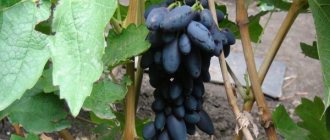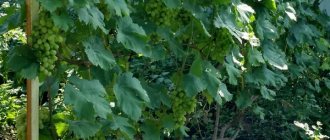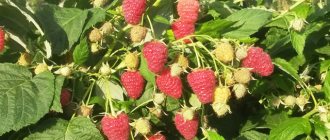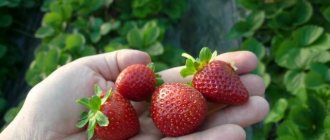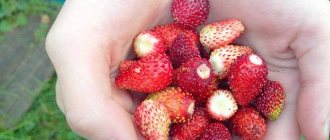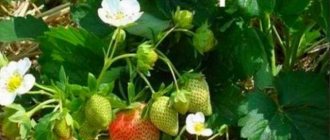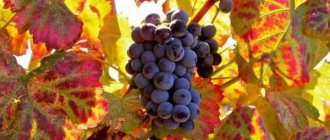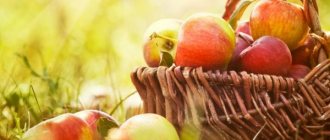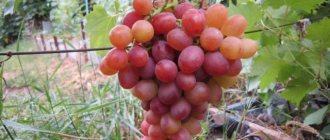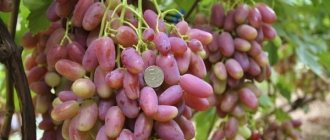Origin
“Valek” is the result of crossing three varieties: “kesha 1”, “star” and “rizamat”. This event was conducted by breeder from Ukraine N.P. Vishnevetsky. The new hybrid form was called “valek” and contained all the best qualities of its “family”. Initially, it was assumed that the variety would be cultivated in the north of Ukraine, but over time it moved to regions located much further north.
The parents of “valek” are “kesha 1”, “star” and “rizamat”
Main characteristics
“Valek” is a vigorous early variety with huge clusters and a wonderful pear taste.
Ripening period
“Valek” is an early variety. About 105–115 days pass from the moment the buds awaken until harvesting. The first clusters can be removed from the bush in young regions already in the first ten days of August.
Bush
Important! There are no problems with pollination of flowers of the “Valek” variety: it will happen even if the weather is rainy and insects do not fly at all.
The bushes of this variety are vigorous. The leaves are green and pubescent on the underside. The flowers are bisexual, their flowering period is about 10 days.
Bunches and berries
The main advantage of the hybrid is the huge clusters weighing 1.5 - 2.5 kg, in which the berries fit tightly to each other.
Oval, dense and fleshy berries weigh about 3–4 grams, and their length and width can reach 3 centimeters. The degree of ripening of the grapes is noticeable on the skin: initially the fruits are greenish-yellow in color, but when fully ripe their surface begins to fill with amber and “brown”. The juicy pulp usually contains 2 – 3 seeds. The berries are moderately sweet (17–29%) with an acidity of 5–6 g/l.
Taste and yield
The taste of the berries of this variety cannot be confused with anything else: they resemble a pear with a light nutmeg aroma. A three-year-old plant is capable of producing 20–22 kg of fruit, but with age, the harvest’s yield only increases: already from a five-year-old bush you can harvest up to 35–40 kg of berries.
Diseases to which the variety is susceptible
If agricultural practices are followed, the grapevine rarely suffers from fungal pathologies. However, prevention is still necessary.
Oidium
Rarely, but still possible, infection with the fungal disease oidium. The leaves become covered with a gray coating, the berries crack on the bushes and become wet. If affected, all damaged leaves and fruits are immediately removed, and the bush is treated with sulfur-based preparations.
Mildew
In cold summers with high rainfall, the fungal disease mildew develops; it is identified by oily spots on the leaves. To treat Valek bushes, copper-containing preparations are used, for example, a solution of Bordeaux mixture.
Comparison with analogues
Valek looks good compared to other early white grape varieties. Read more about this in the table below:
| Sign | Variety | |||
| Outrigger | Aysar | Aleshenkin | Bazhena | |
| Ripening period | 105 – 115 days | 105 – 115 days | 100 – 120 days | 105 – 115 days |
| Frost resistance | -24С | -23C | -26C | -24С |
| Productivity | 35 – 40 kg | Up to 15 kg | 8 – 10 kg | 25 – 30 kg |
| Bunches | 1.5 – 2.5 kg | Up to 600 g | From 300 g to 2 kg | 700g – 1.5 kg |
| Taste | Pear flavor | Harmonious, sweet | Harmonious, sweet | Fruity notes |
| Color | Green-amber | Light green | Amber | Lime-amber |
| Disease resistance | High | Average | Below average | Average |
| Shelf life | 1 – 2 months | 1 – 2 months | 1 month | 1 – 2 months |
| Sugar accumulation | 17 – 19% | 18 – 23C | 17 – 20% | 15 – 16% |
| Acidity | 5 – 6 g/l | 4 – 5 g/l | 3 – 6 g/l | 4 – 6 g/l |
Useful properties and applications
The calorie content of the variety is encouraging - only 45 kcal per 100 grams of product. However, you shouldn’t overuse grapes: a large amount of berries eaten can cause bloating, exacerbation of peptic ulcers and kidney problems, and a spike in blood sugar.
Regular consumption of berries can be recommended to anyone who wants to strengthen their immune system, improve the functioning of the nervous system, increase hemoglobin levels, improve skin condition, and strengthen the walls of blood vessels.
Its main purpose is fresh consumption. You can also make jam, compotes from the berries, or add them to desserts and baked goods. Thanks to their dense consistency and strong peel, they can be pickled and soaked, preparing excellent snacks for the winter.
Features of cultivation
“Valek” is a fairly resistant variety to both disease and frost, but it is poorly stored and quickly deteriorates.
Landing
The most suitable time for planting the variety is autumn, a month before the onset of frost. The winegrower will definitely need to take care of insulating the young and tender plant. Spring planting of seedlings is also allowed, but only if the air and soil are sufficiently warmed (+15ºС and +10ºС, respectively). Grafting is carried out only in early spring, but propagation by cuttings is best done in the summer.
Place and soil
The ideal place for planting a seedling is a well-lit place, protected from drafts and cold winds. It is better if it is a hill or a small mound: this will allow excess moisture to drain safely without provoking putrefactive processes in the roots. “Valek” is unpretentious in relation to the type of soil, but it will not be able to develop normally on saline, swampy and highly acidic soils; black soil, loam and sandy loam are ideal. The option of clay and rocky soil is possible, but it must first be enriched with organic matter.
If it is assumed that future vines will weave along a support in the form of a wall of a house or structure, then to dig a hole it is necessary to retreat 1.5 - 2 meters from them. If tall trees grow nearby, then the distance from them should be even greater: 3 – 5 meters depending on the height of the plants.
The recommended distance between adjacent bushes is 3 meters, between rows - 4 meters. The planting hole should be 80 cm deep, and the diameter should be the same. Shape – square or round. Its bottom should be covered with 20 cm of drainage, and the next layer should be a nutrient mixture (soil, humus or compost, mineral fertilizers). It is necessary to fill the entire hole with it, leaving 40 - 50 centimeters for planting the seedling. The plant itself is crushed with ordinary soil from the site.
Watering and fertilizing
The variety does not require constant watering. During the season it is enough to water it only 3 times: before flowering, during berry set and in late autumn. If the weather is dry for a long time in the summer, unscheduled watering can be carried out. The recommended amount of water applied is 2 buckets for each bush. After the “water procedures”, it is imperative to loosen the top layer of soil, remove all weeds, and then add a layer of peat or sawdust mulch.
Reference! Water must be poured exactly at the root of the plant; if it gets on the leaves, it can cause sunburn.
Fertilizing should also be applied three times during the season. In early spring you need to add organic matter: per 1 sq.m. 6 – 8 kg of manure or 100 g of wood ash. The next feeding is carried out before flowering, the soil is enriched with mineral fertilizers: nitrogen, phosphorus and potassium are mixed in a ratio of 3:2:1, respectively, after which 30 g of the mixture is diluted in a bucket of water, 1 - 2 buckets of solution are poured under each bush. Once again, the bushes are fed with mineral fertilizers during the initial formation of berries. For these purposes, 60–70 g of superphosphate and 20–25 g of potassium sulfate are dissolved in a bucket of water.
Trimming
After planting a young seedling, pruning is not performed during the first year, but on adult bushes an annual two-time procedure of this kind cannot be avoided. In the spring, dry parts and disease-affected shoots are removed, and in the fall, 2 weeks after harvesting, the bush is formed. The number of eyes removed from a shoot depends directly on its diameter: if it is 5 mm, then you need to cut off 5 eyes, 7 mm - 7.8 eyes, 10 mm - 11 - 13 pieces.
The variety also requires pinching the upper part of the shoots even before the inflorescences appear, as well as removing the stepsons and thinning the foliage. This measure allows the shoots to gain additional strength before the crop ripens and stock up on useful elements and water.
Important! The variety needs to ration the yield: no more than two clusters should remain on one fruitful branch, which will lead to enlargement of the berries and an increase in the weight of the bunch.
Diseases and pests
The variety could be called ideal in terms of resistance to diseases and pest attacks, if not for the constant desire of wasps to feast on sweet grapes. The way out of this situation is special bags for the grapes, sweet baits with poison placed around the perimeter of the vineyard, and the destruction of wasp nests.
Although “Valek” is characterized by increased immunity to mildew, oidium, and gray rot, it is still better not to put the grapes at risk and treat them three times a season with fungicides. To avoid fungal infections, it is also necessary to monitor the outflow of excess moisture from the roots of the plant, systematically remove weeds, and apply fertilizers in a timely manner.
Wintering
The variety is considered frost-resistant, as it can withstand temperatures down to -24ºС without damage. However, it is not always possible to accurately predict the weather of the coming winter. If there is little snow and long, severe frosts, the bush may die. To avoid such a nuisance, it is advisable to insulate grapes in northern latitudes and regions with a temperate climate. To do this, you simply need to cover the woody part of the bush with mulch for the winter, cover it with sawdust or cover it with spruce branches.
Harvest storage
The variety can be sent for storage, but, like most early varieties, “Valek” will not be able to “lie” for a long time: 1 – 2 months, provided that the temperature and air humidity are observed.
Care
Subsequent care involves timely watering; watering should be especially abundant during the active growing season.
Then reduce the amount of moisture and renew only in case of drought.
Normalization
The inflorescences on the stepsons need to be removed!
The variety requires normalization of brushes and vines, so breaking off and sanitary pruning is an important method of agricultural technology.
Stepchildren cannot be left on the bushes ; they are eliminated. To limit the growth of the bush in height, it is recommended to pinch the shoots, and this procedure should be carried out before flowering begins.
Large leaves around the brush are torn off, but about four leaves are left.
Prevention
If the summer is rainy, prevention against fungi should be enhanced, since spores spread very quickly in a humid environment.
Timely pruning and thinning of the vine reduces the risk of disease.
The foundation of prevention is ventilation, ensured by the systematic elimination of density.
Along with vacuum , Bordeaux mixture, copper sulfate, and slaked lime . Against oidium, finely ground sulfur is used to treat bushes. Important: plants need to be watered only in the root area.
It is not recommended to wet the green part of the crop.
Application of fertilizers and fertilizers
The main fertilizing with nitrogenous compounds is applied at the beginning of fruit growth.
Fertilizers are applied three times during the entire active period.
- are applied for the first time during planting .
- Next time, before the start of active growing season, nitrogenous fertilizers should be introduced to form leaves, ovaries, inflorescences, brushes - the entire green part of the bush. Further fertilizing is introduced after the end of fruiting - before the onset of winter.
- The last time the crop is fed is to strengthen the plant for the winter . Valek needs iron supplementation, so it is recommended to use iron sulfate to replenish iron deficiency.
Reviews
The clusters are very large, 1500-2500 kg, with beautiful large berries. The berry is fleshy with a pleasant nutmeg and pear flavor. Valek is loved by children and everyone else in the household. Artem, Donetsk region.
It is not affected by gray rot. Very resistant to fungal diseases. Transportable and very productive. Andrey, Vinnitsa
Valek is distinguished by its high yield. But the clusters are dense - unfortunately, this is a big drawback of Valek. It will leave the market quite quickly. Sergey, Lugansk
A very unusual variety, the taste is similar to a pear. Victor, Kherson region.
Reproduction methods
There are several ways to grow grape bushes, each with its own subtleties.
Growing from your own roots
You should purchase a seedling from a nursery or a specialized retail outlet. A cutting from an adult bush is also suitable. In the spring, it is placed in a container with fertile soil and drainage and watered periodically.
Vaccination
This method is characterized by the possibility of rapid growth. But it is difficult to find a suitable rootstock here. You can experiment in this direction.
By layering
This method involves digging up a mature vine without separating it from the mother bush. When its own roots form, the cuttings are cut off and placed in a permanent place.
